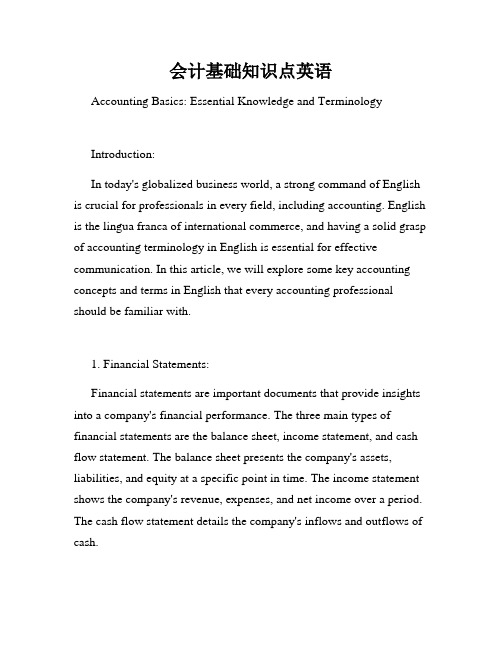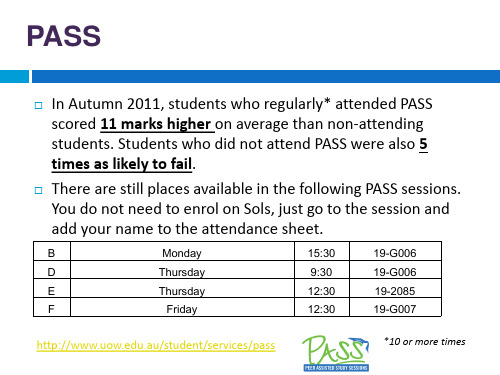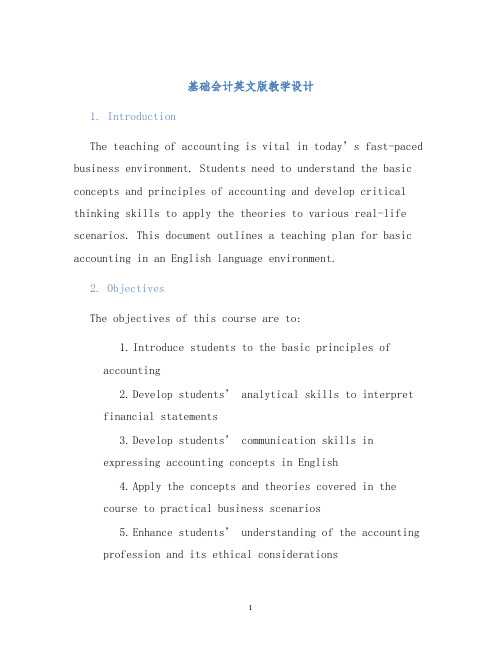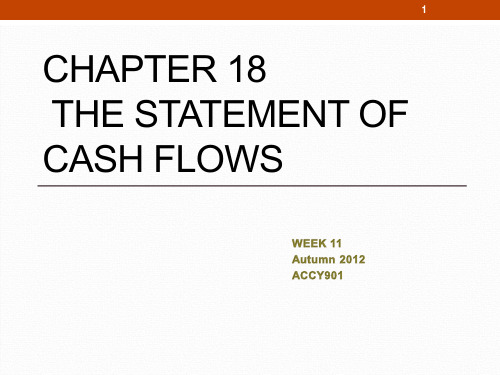AccountingBasics英语会计基础教学
会计基础知识点英文版

会计基础知识点英文版Accounting FundamentalsIntroductionAccounting is a cornerstone of modern business operations, providing a systematic and reliable method for recording, analyzing, and reporting financial transactions.In this article, we will explore some key concepts and principles of accounting. This knowledge is vital for both aspiring accountants and individuals who wish to have abetter understanding of the financial aspects of their personal or professional lives. Let's delve into the world of accounting basics!The Accounting EquationAt the heart of accounting lies the accounting equation, which states that Assets = Liabilities + Equity. Assets are resources owned by a company, such as cash, inventory, or equipment. Liabilities are the company's obligations to repay loans or fulfill other financial commitments. Equityrepresents the owner's claim on the assets after deducting liabilities. Understanding this equation provides afoundation for any accounting analysis.Double-Entry BookkeepingDouble-entry bookkeeping is a fundamental principle of accounting. With this system, every transaction is recordedin at least two accounts: a debit and a credit. Each accountis affected by the transaction in opposite ways. For instance, if cash is received, the cash account is debited, and another account related to the source of the cash is credited. This system ensures accuracy and allows for error detection, blending reliability with accountability.Accrual vs. Cash Basis AccountingThere are two methods of accounting: accrual basis and cash basis. Accrual basis accounting records revenue and expenses when earned or incurred, regardless of when theactual cash is received or paid. This method provides a more accurate representation of the company's financial position. Cash basis accounting, on the other hand, recognizes revenue and expenses only when actual cash changes hands. It is often used by small businesses or individuals with simple financial transactions.Financial StatementsFinancial statements are a vital tool for understanding a company's financial health. They provide a snapshot of its performance, profitability, and overall financial position. The three primary financial statements are the income statement, the balance sheet, and the cash flow statement.The income statement, also known as the profit and loss statement, shows a company's revenues, expenses, and net income or loss over a specific period. It provides insights into a company's operational efficiency and profitability.The balance sheet presents a snapshot of a company's financial position at a specific point in time. It lists the company's assets, liabilities, and equity. The balance sheet provides valuable information about a company's liquidity, solvency, and financial stability.The cash flow statement illustrates the movement of cash in and out of a company during a particular period. It helps gauge a company's ability to generate cash and manage its financial obligations. The cash flow statement is dividedinto three sections: operating activities, investing activities, and financing activities.Accounting Principles and StandardsTo ensure consistency and comparability in financial reporting, accounting principles and standards have been developed. The Generally Accepted Accounting Principles (GAAP) provide guidelines for financial accounting in the United States, while the International Financial Reporting Standards (IFRS) are followed by many countries globally.These principles and standards establish rules for recognizing revenue, measuring assets and liabilities, and disclosing financial information. Adhering to these standards ensures that financial statements are reliable, comparable, and useful for decision-making by investors, creditors, and other stakeholders.ConclusionAccounting fundamentals are essential for anyoneinvolved in financial activities, whether as a professional accountant, a business owner, or an individual managing personal finances. Understanding the accounting equation, double-entry bookkeeping, and financial statements provides a solid foundation for analyzing and interpreting financial data. Furthermore, knowledge of accounting principles and standards ensures accurate and reliable financial reporting. By grasping these concepts, individuals can navigate the complex world of finance with confidence and make informed decisions based on sound financial information.。
AccountingBasics英语会计基础教学课件期末复习

The amount of the estimate for each year is recorded as an adjustment to the Warranty Provision account
Overview | LIABILITIES ~ Current liabilities
Types of current liabilities we’ve covered
Accounts payable Notes payable – same as accounts payable but with interest Unearned revenue – remember the concert example Accrued liabilities – provisions e.g. warranty liability
In this chapter, the focus is mostly on depreciation methods
Straight line (based on years of useful life) Units of production (based on units of useful life) Diminishing (or reducing) balance
EVERYONE wants it!!! So, we need internal control procedures. A fundamental internal control procedure for cash is the bank
基础会计教案语言大学英语

Objective: To introduce students to the fundamental concepts and terms of basic accounting in English, and to develop their ability to understand and communicate basic accounting information.Duration: 1 hourMaterials:- Projector and screen- Handouts with key terms and examples- Whiteboard and markers- Accounting textbooks or online resourcesActivities:I. Introduction (10 minutes)1. Greeting and Introduction- Greet the students and introduce yourself.- Briefly explain the importance of accounting in business and finance.2. Objectives for the Lesson- Explain the objectives of the lesson, which include understanding basic accounting terms and concepts.II. Presentation of Key Terms (20 minutes)1. Assets- Define assets as resources owned by a company that have economic value.- Provide examples: cash, equipment, inventory, property.2. Liabilities- Define liabilities as obligations of a company to pay debts or fulfill promises.- Provide examples: accounts payable, loans, taxes payable.3. Equity- Define equity as the residual interest in the assets of the entity after deducting liabilities.- Explain that equity is also known as owner's equity or shareholders' equity.4. Revenue- Define revenue as the income earned by a company from its primary business activities.- Provide examples: sales revenue, service revenue.5. Expenses- Define expenses as the costs incurred by a company in the process of generating revenue.- Provide examples: salaries, rent, utilities, cost of goods sold.III. Exercises (15 minutes)1. Match the Terms- Provide a list of key terms and a list of their definitions. Ask students to match the terms with their correct definitions.2. Example Analysis- Show a simple balance sheet and income statement. Ask students to identify the assets, liabilities, equity, revenue, and expenses.IV. Group Discussion (10 minutes)1. Case Study- Present a short case study related to basic accounting, such as a company's financial statements.- Divide the class into small groups and ask them to discuss the financial health of the company based on the provided information.2. Reporting Back- Each group reports back to the class, summarizing their findings and discussing any challenges they faced.V. Conclusion and Homework (5 minutes)1. Summary- Summarize the key points discussed in the lesson.2. Homework Assignment- Assign a reading from the textbook or online resources on basic accounting principles.- Ask students to complete a practice problem set related to the key terms and concepts covered in the lesson.Assessment:- Participation in class discussions- Completion of the homework assignment- Performance on a short quiz covering the key terms and concepts introduced in the lesson.Additional Notes:- Encourage students to ask questions and provide clarifications throughout the lesson.- Use visual aids, such as diagrams and charts, to enhance understanding.- Provide additional resources for students who may need further assistance with the material.。
Accounting Basics英语会计基础教学(7)PPT课件

概述二
点击此处输入
相关文本内容
概述三
点击此处输入
相关文本内容
Learning Objectives
Describe how the cost principle applies to property, plant and equipment (PPE)
Explain the concept of depreciation and calculate periodic depreciation using different methods
fees Real estate agents’ commissions Accrued property taxes and other liens on
the land assumed by the purchaser
6
Determining the cost of PPE
continued
4
LO1 Determining the cost of PPE
Cost principle requires PPE initially be recorded at cost
Cost consists of all expenditures necessary to acquire the asset and make it ready for its intended use
They are also called fixed assets They are expected to provide services for a
number of years but decline in service potential over their useful lives
Accounting Basics英语会计基础教学课件(5)

SPECIAL JOURNALS continued
8
The types of special journals used depend largely on
the types of transactions that occur frequently in a business enterprise Examples
Example: Recall from the previous lecture that a normal sales transaction, when a perpetual inventory system is used, requires two journal entries that looks like this…
6,000 1,750 2,940 60 3,000 6,000
5,000
3,100
1,750
Cash receipts journal continued
14
Posting the cash receipts journal
1.
2.
3.
All column totals (excluding other accounts) posted to account specified Individual accounts in „other accounts‟ posted separately to relevant individual general ledger accounts Individual amounts, posted in total to Accounts Receivable control account, posted to individual subsidiary ledger accounts
会计基础知识点英语

会计基础知识点英语Accounting Basics: Essential Knowledge and TerminologyIntroduction:In today's globalized business world, a strong command of English is crucial for professionals in every field, including accounting. English is the lingua franca of international commerce, and having a solid grasp of accounting terminology in English is essential for effective communication. In this article, we will explore some key accounting concepts and terms in English that every accounting professional should be familiar with.1. Financial Statements:Financial statements are important documents that provide insights into a company's financial performance. The three main types of financial statements are the balance sheet, income statement, and cash flow statement. The balance sheet presents the company's assets, liabilities, and equity at a specific point in time. The income statement shows the company's revenue, expenses, and net income over a period. The cash flow statement details the company's inflows and outflows of cash.2. Assets and Liabilities:Assets are resources that a company owns and can use to generate future economic benefits. They are classified into two categories: current assets and non-current assets. Current assets include cash, accounts receivable, and inventories, while non-current assets comprise property, plant, and equipment. Liabilities, on the other hand, are obligations that a company owes to external parties. They can be either short-term liabilities, such as accounts payable, or long-term liabilities, such as bank loans.3. Revenue and Expenses:Revenue represents the inflow of assets resulting from the company's ordinary activities, such as sales of goods or services. It is essential for the income generation of the company. Expenses, on the other hand, are outflows of assets incurred in the course of the company's operations. They include costs related to production, administration, and marketing. The difference between revenue and expenses is known as net income (or net loss if expenses exceed revenue).4. Depreciation and Amortization:Depreciation and amortization are accounting methods used to allocate the cost of long-term assets over their useful lives.Depreciation typically applies to tangible assets, such as buildings and machinery, while amortization applies to intangible assets, such as patents or copyrights. These methods recognize that assets lose value over time and account for this decline by spreading the cost over the asset's estimated useful life.5. Equity and Retained Earnings:Equity represents the ownership interest in a company. It is the residual interest in the assets after deducting liabilities. Equity can be divided into two main components: contributed capital and retained earnings. Contributed capital refers to the funds contributed by shareholders in exchange for ownership shares, while retained earnings are the accumulated profits that are reinvested in the business rather than distributed to shareholders as dividends.Conclusion:Accounting is a universal language that helps businesses communicate their financial health and performance. As globalization continues to shape the business landscape, accountants who are proficient in English and possess a solid understanding of accounting terminology will have a competitive advantage. This article provided an overview of key accounting concepts and terms in English, servingas a foundation for further exploration and learning in the field of accounting.。
Accounting Basics英语会计基础教学课件(4)

(to record return of unwanted inventory purchased on account)
ACCY901 A'12
Recording freight costs
If the buyer pays the freight costs, these are treated as part of the cost of the inventory. BUT, we still record freight costs in a separate account This is the SAME entry for the periodic and perpetual systems
Operating cycles
4
SERVICE BUSINESS
Perform service Accounts receivable Send invoice Receive cash
MERCHANDISING BUSINESS
Buy inventory Sell inventory Accounts receivable Send invoice Receive cash
Date Account Debit Credit
Nov 1 Inventory
5,000
Nov 1 le
5,000
Accounts payable
5,000
(to record purchase of inventory on account)
D E
Thursday Thursday
9:30 12:30
19-G006 19-2085
F
Friday
AccountingBasics英语会计基础教学课件

The $400 is still a March expense because this is the period in which the expense was incurred. The actual cash won’t go out until April, but the expense is still a March expense.
We need to make sure that asset and liability balances are accurately reflected at the end of the accounting period
Adjusting entries occur after the transactions have been recorded and posted, but before the financial statements are prepared
4
Before we start…
Last week we looked at transactions analysis, journal entries and general ledger accounts…Elena Lee example
Transaction
1 October, office rent for October is paid in cash, $1800
.au/student/services/pass
Chapter 3: Adjusting the accounts
Week 3
2
BEFORE WE START….
基础会计英文版教学设计

基础会计英文版教学设计1. IntroductionThe teaching of accounting is vital in today’s fast-paced business environment. Students need to understand the basic concepts and principles of accounting and develop critical thinking skills to apply the theories to various real-life scenarios. This document outlines a teaching plan for basic accounting in an English language environment.2. ObjectivesThe objectives of this course are to:1.Introduce students to the basic principles ofaccounting2.Develop students’ analytical s kills to interpretfinancial statements3.Develop students’ communication skills inexpressing accounting concepts in English4.Apply the concepts and theories covered in thecourse to practical business scenarios5.Enhance students’ understanding of the account ingprofession and its ethical considerations3. Course Outline3.1 Course OverviewThis course ms to provide students with a solid understanding of fundamental accounting concepts and techniques. The course will cover the following topics: •The accounting equation•Recording financial transactions•The trial balance•Adjusting entries•Financial statements•The statement of cash flows•Inventory valuation•Depreciation and amortization•Liabilities and equity•Revenues and expenses•Financial statement analysis•Accounting ethics and professionalism3.2 Course ScheduleWeek Topic RequiredReading SupplementaryMaterialsAssignments1 Introduction to Chapter 1 Business News QuizReading Materials Accounting Articles2 The AccountingEquation Chapter 2 Real-lifefinancialstatementsHomework3 RecordingFinancialTransactionsChapter 3 Case studies Quiz4 The Trial Balance Chapter 4 VideotutorialsHomework5 Adjusting Entries Chapter 5 Business NewsArticlesQuiz6 FinancialStatements Chapter 6 Real-lifefinancialstatementsHomework7 The Statement ofCash FlowsChapter 7 Case studies Quiz8 InventoryValuation Chapter 8 VideotutorialsHomework9 Depreciation andAmortization Chapter 9 Business NewsArticlesQuizReading Materials10 Liabilities andEquity Chapter10Real-lifefinancialstatementsHomework11 Revenues andExpenses Chapter11Case studies Quiz12 FinancialStatementAnalysis Chapter12VideotutorialsHomework13 Accounting EthicsandProfessionalism Chapter13Business NewsArticlesQuiz14 Review andEvaluation ReviewallchaptersReviewquestions andexercisesFinal exam4. Teaching Strategies4.1 LecturesLectures will be used to introduce new concepts and theories. These will be conducted in English to enhance students’ language skills and familiarity with accounting terminology.4.2 Case StudiesCase studies will be used to analyse and interpret real-life business scenarios. These cases will be designed to stimulate critical thinking and problem-solving skills.4.3 HomeworkHomework assignments will be used to reinforce the concepts and theories covered in class. These assignmentswill be graded and contribute to the final course grade.4.4 QuizzesQuizzes will be given after each topic to ensure students have a strong understanding of the concepts covered. These quizzes will be graded and contribute to the final course grade.4.5 Final ExamThe final exam will cover all topics covered in the course and will test students’ understanding and application of accounting concepts in English.5. AssessmentThe assessment will include a range of methods to evaluate students’ understanding of the course material, includinghomework assignments, quizzes, and a final exam. The breakdown of grades is as follows:Assessments WeightingHomework Assignments 30%Quizzes 30%Final Exam 40%6. ConclusionThis teaching plan ms to provide students with a comprehensive understanding of fundamental accounting concepts and techniques. The course will be conducted in English to enhance students’ language skills and familiarity with accounting terminology. A range of teaching strategies will be employed to stimulate critical thinking and problem-solving skills. The assessment will be based on a combination of homework assignments, quizzes, and a final exam.。
2019年最新-AccountingBasics英语会计基础教学课件-精选文档

How much revenue should Penny record for 2019? Revenue for 2019 would be $22,400
Why?
Sales – Cash
$20,000
Sales – Accounts receivable $ 2,400
Total sales for 2019
debit. To increase balance debit again, to credit. To increase balance credit again,
decrease credit out of the account.
to decrease debit out of the account.
7
Accrual versus cash basis of accounting
Cash-based accounting
Revenue recognised when the cash is received or paid.
Accrual-based accounting
Revenue recognised when goods and services are provided
Expenses recognised when the cash is received or paid
8
Expenses recognised when assets are consumed or liabilities incurred
Cash versus accrual basis
Basic analysis
The expense Rent is increased $1800 because the payment pertains only to the current month; the asset Cash is decreased $1800
Accounting Basics英语会计基础教学(3)PPT课件

Journal entry Posting
Oct 1 Rent Expense
601 1800
Cash
101
(Paid October rent)
1800
Rent Expense 601 Oct 1 1800
Cash
101
Oct 1 800
7
This week…
Accrual versus cash basis of accounting Revenue recognition criteria Expense recognition criteria Types of adjusting entries Prepayments Accruals Adjusted trial balance Worksheets Financial statements from worksheets
.au/student/services/pass
1
第一部分
整体概述
THE FIRST PART OF THE OVERALL OVERVIEW, PLEASE SUMMARIZE THE CONTENT
2
Chapter 3: Adjusting the accounts
Expenses recognised when the cash is received or paid
Expenses recognised when assets are consumed or liabilities incurred
9
Cash versus accrual basis
Accrual basis
Income example: assume Penny received $20,000 in cash for sales during 2011 and charged clients $2,400 which was to be paid in the following year.
Accounting Basics英语会计基础教学课件.ppt

1
•Basic principles of accounting information systems •Nature and purpose of a subsidiary ledger •How special journals are used •How to use a multicolumn journal •NOTE: download templates of all these journals from the elearning space!
Relevant, reliable, understandable, timely, comparable
Flexibility
Technological advances, increased competition, changing accounting principles, organisational growth, government regulation and de-regulation
Developing an accounting system
4
1. Analysis
Planning and identifying information needs and sources
2. Design
Creating forms, documents, procedures, job descriptions and reports
Examples
Sales journal Cash receipts journal Purchases journal Cash payments journal
Accounting Basics英语会计基础教学(8)PPT课件

Factors influencing new share issue price include:
o Anticipated future earnings o Expected dividend rate per share o Current financial position o Current state of the economy o Current state of the securities market
7
Share issue considerations
Issue of Shares
A company can issue ordinary shares
o Directly to investors, or o Indirectly through an underwriter (such as an
o The total amount of cash and other assets paid to the company by shareholders
o Share may be ordinary or preference shares
10
Shareholders’ equity
5
Forming a company
Application filed with ASIC showing
o Name and purpose of company o Number and types of shares o Names of incorporators
Company constitution regulates internal management
4
Characteristics of a
AccountingBasics英语会计基础教学课件.pptx

Transactions between a company and its owners or between a company and its longterm creditors. Examples include:
Cash inflows from…
Cash outflows to…
Issuing shares and other
• Financing activities
• Cash effects resulting from long-term borrowing and shareholders’ equity
6
Operating activities
•Are transactions involving the acquisition or production of goods and services and the sale and distribution of these goods and services to customers.
• Significant financing and investing activities that do not affect cash are not reported in the body of the statement of cash flows, but are disclosed elsewhere in the financial statement
LO1
• A statement of cash flows provides information about an entity’s cash receipts and cash payments during a period
Accounting Basics英语会计基础教学(10)PPT课件

• Where did the cash come from during the period? • What was the cash used for during the period? • What was the change in the cash balance during
•Current asset and current liability transactions normally result from the operating activities of a company, such as buying and selling merchandise.
Investing activities
1
Chapter 18 The statement of cash flows
WEEK 11 Autumn 2012
ACCY901
第一部分
整体概述
THE FIRST PART OF THE OVERALL OVERVIEW, PLEASE SUMMARIZE THE CONTENT
3
Learning Objectives
• Ability to generate future cash flows • Ability to pay dividends and meet obligations • Reasons for difference between profit and net
cash provided (used) by operating activities • Cash investing and financing transactions for the
会计专业英语知识点汇总

会计专业英语知识点汇总会计专业是现代商业领域中非常重要的一门专业。
在学习会计专业时,除了掌握会计理论和实践技巧外,掌握一定的英语知识也是非常重要的。
本文将为大家汇总一些会计专业的英语知识点,希望能够帮助到学习会计专业的同学们。
1.会计基础知识 (Accounting Basics)–Assets:资产–Liabilities:负债–Equity:所有者权益–Revenue:收入–Expenses:费用–Balance Sheet:资产负债表–Income Statement:损益表–Cash Flow Statement:现金流量表2.会计准则和规范 (Accounting Standards and Regulations)–Generally Accepted Accounting Principles (GAAP):通用会计准则–International Financial Reporting Standards (IFRS):国际财务报告准则–Financial Accounting Standards Board (FASB):美国财务会计准则委员会–International Accounting Standards Board (IASB):国际会计准则委员会3.资产负债表相关术语 (Balance Sheet Terminology)–Current Assets:流动资产–Non-current Assets:非流动资产–Current Liabilities:流动负债–Non-current Liabilities:非流动负债–Shareholders’ Equity:股东权益–Goodwill:商誉–Depreciation:折旧–Amortization:摊销4.损益表相关术语 (Income Statement Terminology)–Gross Profit:毛利润–Operating Income:营业收入–Operating Expenses:营业费用–Net Income:净收入–Earnings per Share (EPS):每股收益5.现金流量表相关术语 (Cash Flow Statement Terminology)–Cash Inflows:现金流入–Cash Outflows:现金流出–Operating Activities:经营活动–Investing Activities:投资活动–Financing Activities:筹资活动–Net Cash Flow:净现金流量6.会计报表分析 (Financial Statement Analysis)–Ratio Analysis:比率分析–Liquidity Ratios:流动性比率–Solvency Ratios:偿债能力比率–Profitability Ratios:盈利能力比率–Efficiency Ratios:效率比率7.审计和内部控制 (Auditing and Internal Control)–Audit:审计–Internal Control:内部控制–Segregation of Duties:职责分离–Internal Audit:内部审计–External Audit:外部审计8.税务会计 (Tax Accounting)–Taxable Income:应税收入–Tax Deductions:税收减免–Tax Credits:税收抵免–Tax Liability:税务负债–Tax Planning:税务规划这些是会计专业中一些重要的英语知识点,希望能够帮助到学习会计专业的同学们。
- 1、下载文档前请自行甄别文档内容的完整性,平台不提供额外的编辑、内容补充、找答案等附加服务。
- 2、"仅部分预览"的文档,不可在线预览部分如存在完整性等问题,可反馈申请退款(可完整预览的文档不适用该条件!)。
- 3、如文档侵犯您的权益,请联系客服反馈,我们会尽快为您处理(人工客服工作时间:9:00-18:30)。
2
STATEMENT OF CASH FLOWS: USEFULNESS AND FORMAT
LO1
• A statement of cash flows provides
information about an entity’s cash receipts and cash payments during a period
• Ability to pay dividends and meet obligations • Reasons for difference between profit and net
cash provided (used) by operating activities • Cash investing and financing transactions for the period
1
• Indicate the usefulness of the statement of cash
flows • Distinguish among operating, investing and financing activities • Prepare a statement of cash flows using the direct method • Statement of cash flows- the indirect method
8
Significant non-cash activities
• Significant financing and investing activities that
do not affect cash are not reported in the body of the statement of cash flows, but are disclosed elsewhere in the financial statement • Examples include …
Sale of non-current assets (PP&E, intangibles, share investments) Repayments of loans advanced to other parties
Cash outflows to…
Acquire non-current assets (PP&E, intangibles, share investments) Lend money to othe of cash flows
LO2
• Operating activities • Cash effects of transactions that create income and expenses • Investing activities • Cash effects resulting from acquisition and disposal of long-term assets • Financing activities • Cash effects resulting from long-term borrowing and shareholders’ equity
• It answers the questions: • Where did the cash come from during the period? • What was the cash used for during the period? • What was the change in the cash balance during the period?
Investing activities
The acquisition/disposal of long-term assets and other investments during a financial period. . Examples include:
Cash inflows from…
3
Usefulness of the statement of cash flows
• Helps investors, creditors and other
interested parties to evaluate the following about the entity:
• Ability to generate future cash flows
5
Operating activities
• Are transactions involving the acquisition or production of goods and services and the sale and distribution of these goods and services to customers. • Current asset and current liability transactions normally result from the operating activities of a company, such as buying and selling merchandise.
Financing activities
Transactions between a company and its owners or between a company and its longterm creditors. Examples include:
Cash inflows from… Cash outflows to… Issuing shares and other Buy back shares equity instruments Issuing bonds and other Repay bonds and other borrowings borrowings Pay dividends (cash dividend)
